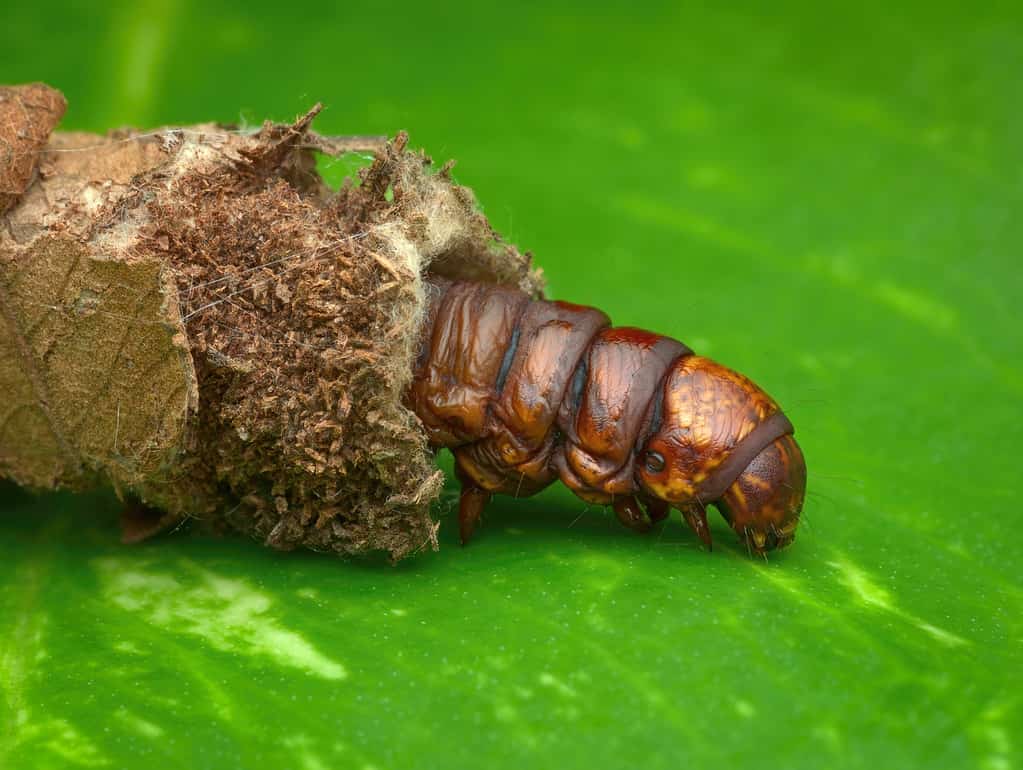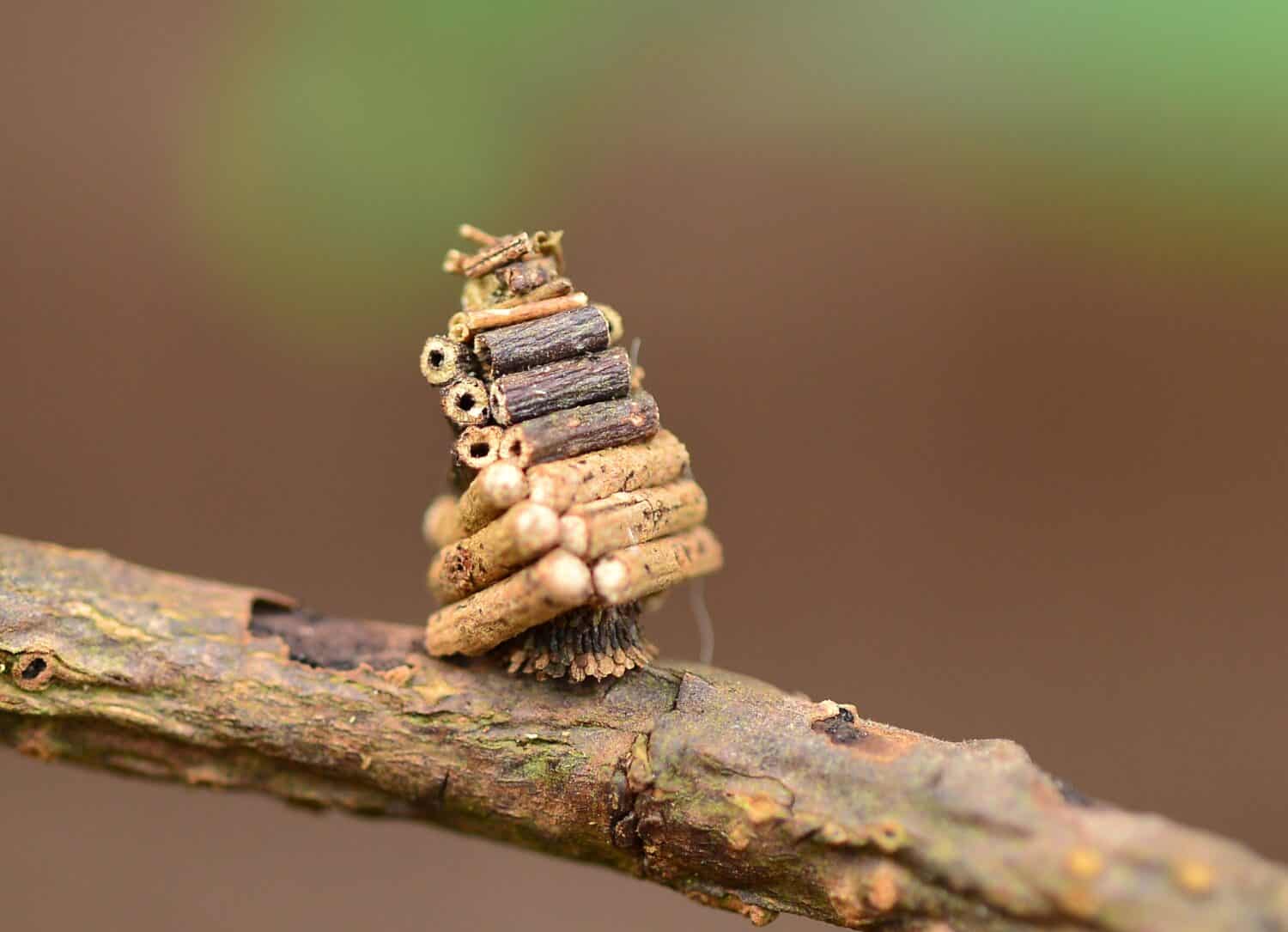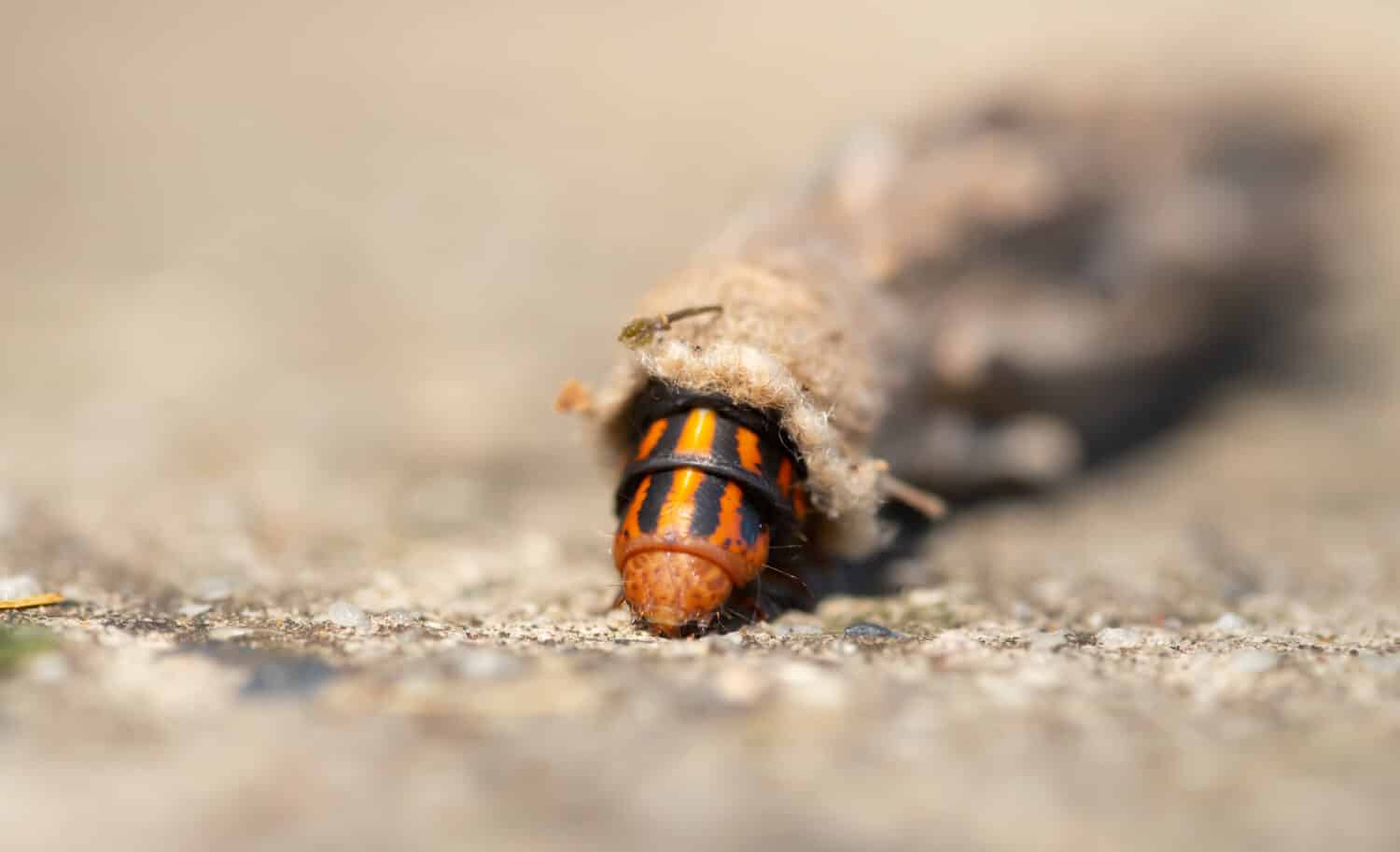Bagworm Moth Caterpillar
Bagworm moth caterpillars build protective cases around themselves that occasionally resemble tiny log cabins!
Advertisement
Bagworm Moth Caterpillar Scientific Classification
Read our Complete Guide to Classification of Animals.
Bagworm Moth Caterpillar Conservation Status
Bagworm Moth Caterpillar Facts
- Name Of Young
- Larvae
- Group Behavior
- Infestation
- Fun Fact
- Bagworm moth caterpillars build protective cases around themselves that occasionally resemble tiny log cabins!
- Biggest Threat
- Birds
- Most Distinctive Feature
- They build protective cases around themselves in addition to cocoons
- Wingspan
- Between 0.47 and 1.42 inches
- Habitat
- Deciduous and coniferous forests, any area with appropriate plant life
- Predators
- Birds, wasps
- Diet
- Herbivore
- Lifestyle
- Diurnal
- Favorite Food
- Leaves, needles, fruits, flowers
- Origin
- North America
- Number Of Species
- 1350
- Slogan
- They continually enlarge their protective cases
- Group
- Army
Bagworm Moth Caterpillar Physical Characteristics
- Color
- Yellow
- Black
- Skin Type
- Exoskeleton
- Length
- Up to 1.5 inches
- Venomous
- No
- Aggression
- Low
View all of the Bagworm Moth Caterpillar images!
Bagworm Moth Caterpillar Summary
Bagworm moth caterpillars are the larvae of bagworm moths, which belong to the family Psychidae. They weave silk cocoons for themselves after hatching, typically fortifying these cocoons with structures called “cases.” These structures are made of leaves, twigs, and similar materials and often resemble tiny log cabins. This has given rise to the nickname “case moths.” After pupating, they emerge as adult bagworm moths. Unfortunately, they can be destructive to plant life in their larval stage.
Bagworm Moth Caterpillar Species, Types, and Scientific Name

The bagworm caterpillar lives in its protective bag, or case, with only the male moth leaving to mate.
©Lawrence Jefferson/Shutterstock.com
Bagworm moth caterpillars are bagworm moths in the larval stage. They comprise the family Psychidae within the order Lepidoptera (butterflies and moths). Bagworm moths also go by the common names “bagworms,” “bagmoths,” or “case moths.” Scientists place them within the class Insecta, classifying them as insects due to characteristics like their six jointed legs, segmented bodies, and exoskeletons.
The family Psychidae contains approximately 1,350 species of bagworms in around 300 genera. This includes the following species:
- Evergreen bagworm moth (Thyridopteryx ephemeraeformis)
- Abbot’s bagworm moth (Oiketicus abbotii)
- Common bagworm moth (Psyche casta)
- Common bag moth (Liothula omnivore)
- Wattle bagworm (Kotochalia junodi)
- Hairy sweep (Canephora hirsuta)
- Australian bagmoth (Cebysa leucotelus)
- Snailcase bagworm (Apterona helicoidella)
- Fangalabola (Deborrea malgassa)
Appearance: How to Identify Bagworm Moth Caterpillars

Bagworm caterpillars cover themselves with a protective case.
©iStock.com/Abdul Latif
Bagworm moth caterpillars are typically pale yellow with black markings on their bodies. They typically grow up to 1.5 inches in length. As insects, they have six jointed legs. They are quick to construct cocoons after hatching from their eggs.
After weaving a silk cocoon around itself, each bagworm larva will then construct a protective “case.” The appearance of the case varies as its materials come from the larva’s immediate environment. The most striking example of a bagworm moth caterpillar case is the “log cabin” style, which resembles a tiny log cabin. Other times, the case may appear to be a malformed pine cone or simply a pile of twigs and leaves. The caterpillar will continue to build up its case throughout the pupate stage. Cases range from less than 0.4 inches to 5.9 inches in length. Both ends are tapered and open.
Adult male bagworms are black and fuzzy with fully developed wings. The wingspan of an adult male bagworm measures between 0.47 and 1.42 inches. Most adult females either grow vestigial wings or none at all. They live perpetually in a pupal state, partially encased in their cocoon.
Habitat: Where to Find Bagworm Moth Caterpillars

Once the life cycle of the bagworm caterpillar to moth is complete, the cases remain on greens, sometimes falling off.
©TRR/Shutterstock.com
Species of bagworm moths, and therefore their caterpillars, occur globally on every continent except Antarctica. In the U.S., they occur throughout the eastern half of the United States and South Dakota, Nebraska, Kansas, and Texas. They live wherever they can access host plants, especially deciduous and coniferous forests. They also venture into urban or suburban areas with these types of trees or other plant life, making nuisances of themselves by ruining vegetation.
Evolution and History
The order Lepidoptera (butterflies and moths) comprises approximately 160,000 extant species. Some of the oldest Lepidoptera fossils occurred 15 million years ago during the Miocene Epoch (23.03 to 5.33 MYA) in the Neogene Period. However, some butterfly fossils may date back to 40 million years ago. However, scientists speculate that the earliest ancestors of modern moths may have emerged during the Carboniferous Period some 300 million years ago. Moths and butterflies most likely began to diversify with the appearance of angiosperms (flowering plants).
The current sexual dimorphism of the bagworm moth manifests itself chiefly in the wingless state of its adult females. This dimorphism is likely the result of a two-step evolutionary process. The first step involved the reduction of the female’s fully-sized wings to nonfunctional vestigial wings. The second step involved the further reduction of the adult female to a vermiform state without functional wings or legs. Some scientists believe this evolutionary transformation occurred independently at least twice.
Diet: What Do Bagworm Moth Caterpillars Eat?
These caterpillars eat by sticking their heads out of their cocoons and feeding on the plant life around them. For this reason, they are destructive pests that often contribute to the poor health of trees and other vegetation in large numbers.
What Do Bagworm Moth Caterpillars Eat?
Bagworm larvae primarily eat the leaves and needles of trees and shrubs. Targeted deciduous trees include maples, oaks, box elders, and willows. Targeted coniferous trees include pines, spruces, firs, junipers, and eastern red cedars. These insects also occasionally go after fruit trees and flowers.
What Eats Bagworm Moth Caterpillars?
Bagworm larvae commonly fall prey to birds like woodpeckers, sapsuckers, and sparrows. A particular type of parasitical wasp, the ichneumon wasp, preys on these insects by laying its eggs inside them.
Prevention: How to Get Rid of Bagworm Moth Caterpillars

The female bagworm mother caterpillar is flightless.
©Nipuna Dodangoda/Shutterstock.com
The signs of a bagworm moth infestation are relatively easy to spot. They include trees with dead branches, missing needles or leaves, brown spots on vegetation, and brown bags or cases among the branches.
A simple but time-consuming way to get rid of bagworm moth caterpillars is to pick them off the trees or shrubs in question one by one. This is somewhat difficult as they use a special substance to firmly anchor their cocoons in place. A more efficient way to combat an infestation is to spray the affected vegetation with chemicals like acephate, cyfluthrin, and spinosad. However, caution is recommended as these can have unintended side effects on other, harmless forms of insect life in the area. Another option is to use Bt (Bacillus thuringiensis), a soil bacterium that sickens bagworm larvae. See this guide for a more complete discussion of bagworm larvae control methods.
Bagworm Moth Caterpillars FAQ
Are bagworm moth caterpillars dangerous?
Bagworm larvae are not dangerous to humans.
Are bagworm moth caterpillars pests?
Bagworms cause damage to trees and other vegetation in their larval state. Insecticides may be necessary to stop serious infestations.
How do you identify bagworm moth caterpillars?
Bagworm larvae wrap themselves in silk cocoons and outer cases made of twigs, leaves, and other materials. The caterpillars themselves are pale yellow with black markings.
How many legs do bagworm moth caterpillars have?
Like all insects, bagworm moth larvae have six jointed legs.
Are bagworm moth caterpillars endangered?
Bagworm moths are not currently on the IUCN’s Red List of threatened species.
What do bagworm moth caterpillars turn into?
Bagworm moth larvae become pupae when they enter their cocoons. Eventually, they emerge as bagworm moths.
Related Animals:
View all 285 animals that start with BThank you for reading! Have some feedback for us? Contact the AZ Animals editorial team.
Sources
- Amusing Planet, Available here: https://www.amusingplanet.com/2016/01/log-house-like-cocoon-of-bagworm-moth.html
- Entomology Today, Available here: https://entomologytoday.org/2020/10/30/insect-costume-designers-dressed-impress-halloween/bagworm-moth-caterpillar-log-cabin/
- PennState Extension, Available here: https://extension.psu.edu/bagworms
- Florida Museum Science, Available here: https://www.floridamuseum.ufl.edu/science/dna-tells-story-butterfly-evolution/
- Evol Dev. 2017 Jan, Available here: https://pubmed.ncbi.nlm.nih.gov/27869366/
- US Forest Service, Available here: https://www.fs.usda.gov/Internet/FSE_DOCUMENTS/stelprdb5347210.pdf
- Butterflies and Moths of North America, Available here: https://www.butterfliesandmoths.org/taxonomy/Psychidae
- BugGuide, Available here: https://bugguide.net/node/view/122
- Mindat, Available here: https://www.mindat.org/taxon-8861.html
- (1970)

















